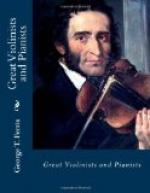A good example is the fantasia on Mozart’s “Don Giovanni.” The little, wild, unformed melodies rustle in quick gusts along the keys as if wavering shadows, yet with all the familiar rhythm and family likeness, filling the mind of the hearer with the atmosphere and necessity of what is to follow, while gradually the full harmonies unfold themselves. The introduction of the minuet is one of the most striking portions. The scene of the minuet in the opera is a vision of rural loveliness and repose, whispering of flowers, fields, and happy flying hours. All this becomes poetized, and the music seems to imply rich reaches of odorous garden and moonlight, whispering foliage, and nightingales mad with the delight of their own singing, and a palace on the lawn sounding with riotous mirth. The player-composer weaves the glamour of such a dream, and the hearer finds himself strolling in imagination through the moonlit garden, listening to the birds, the waters, and the rustling leaves, while the stately beat of the minuet comes throbbing through it all, calling up the vision of gayly dressed cavaliers and beautiful ladies fantastically moving to the tune. Such poetic sentiment as this of the purely picturesque sort was in large measure Thalberg’s possession, but he could never understand that turbulent ground-swell of passion which music can also powerfully express, and by which the soul is lifted up to the heights of ecstasy or plunged in depths of melancholy. Music as a vehicle for such meanings was mere Egyptian hieroglyphic, utterly beyond his limitation, absolute bathos and absurdity.
It is doubtful whether any player ever possessed a more wonderfully trained mechanism; the smallest details were polished and finished with the utmost care, the scales marvels of evenness, the shakes rivaling the trill of a canary bird. His arpeggios at times rolled like the waves of the sea, and at others resembled folds of transparent lace floating airily with the movements of the wearer. The octaves were wonderfully accurate, and the chords appeared to be struck by steel mallets instead of fingers. He was called the Bayard of pianists, “le Chevalier sans peur et sans reproche.” His tone was noble, yet mellow and delicate, and the gradations between his forte and piano were traced most exquisitely. In a word, technical execution could go no further. It is said that he never played a piece in public till he had absolutely made it the property of his




